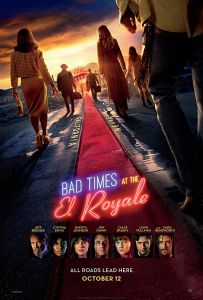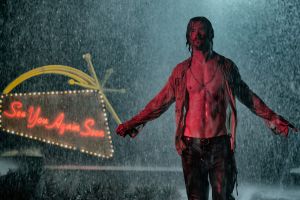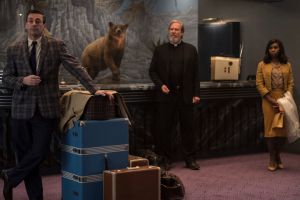Extremely suspenseful, fun and heartfelt, 20th Century Fox’s “Bad Times at the El Royale” proves to be a wicked good time. The film is viciously unpredictable, stuffed with a visually stunning ‘60s wardrobe and a cast of scene-stealing stars. Adding in sophisticated and thought-provoking writing, it is one of the best thrillers in years.
The noir mystery thriller follows seven strangers, each with a dark secret, who check into the El Royale hotel in Tahoe, California. The characters include Jeff Bridge’s aging bank robber, Cynthia Erivo’s struggling singer, Dakota Johnson’s southern criminal, Jon Hamm’s smooth-talking vacuum salesman, Cailee Spanley’s young cult member, Lewis Pullman’s hotel clerk and Chris Hemsworth’s charismatic but frightening cult leader.

The film goes in depth with each of the characters’ backstories, making it seem as if seven different tales are making up the film as a whole. The backstories add context to events happening inside the hotel such as kidnapping, spying, robbery and even murder. As the film progresses, tensions rise between the characters and mysteries are uncovered, all leading to countless twists and turns that steal the breath away from audience members. Standout performers Jeff Bridges, Cynthia Erivo, Chris Hemsworth and Dakota Johnson follow the lead of director Drew Goddard and take the film to unexpected depth, heart and social subtext.
With so many storylines, each one is a hit or miss in terms of quality. Most stories offer rich character development, however, one story in particular—that of Pullman’s hotel clerk— feels clunky, silly and unwarranted. Near the end of the film, the backstory to Pullman’s character is revealed but is laughably overdramatic, making the film seem like it’s trying too hard to prompt an emotional response out of the viewer. Instead of eliciting the desired jaw-dropping effect earned by the other storylines, this one seems like a slow, uninteresting detour from the main story.

“Bad Times” is Goddard’s second time behind the wheel of a feature film, but he drives it with a strict vision, feel and visual palette. Each shot is packed with as much visual appeal as possible, and the ‘60s setting adds for unique and inspired stylistic choices. The walls are covered with neon signs, old cars are parked out front and a classic looking jukebox lined in gold sits in the center of a California wildlife-themed common area. Goddard layers on suspense as secrets and backstories are revealed for each troubled character and the audience is immediately hooked through the smart and witty dialogue. Despite all of the other strategies Goddard employs, the writing in the film is what makes it truly stand out from other thriller pictures. No word spoken is unnecessary—each word is intricately chosen for maximum emotional impact, and a storyline involving Jeff Bridges’ character’s memory loss is exceptionally powerful.
Of course, the dialogue couldn’t have the desired impact without the actors. Each of the seven stars’ characters are well developed, providing riveting, layered and nuanced performances that give their characters personality and depth. Erivo and Bridges ultimately steal the show, delivering surprisingly heartfelt performances as their characters’ storylines intertwine. Erivo plays a talented and troubled singer living from paycheck to paycheck and Bridges plays a humble, intense and forgetful man impersonating a priest for mysterious reasons. Erivo’s ability to act is easily eclipsed by her singing. She delivers beautiful, encapsulating performances throughout the film, each sung at just the right moment for a meaningful character beat. Bridges offers a fully engaging performance playing a wonderfully charismatic, but wounded criminal. The interactions between these two characters also provide interesting social subtext involving race, and their relationship is one of the more poignant aspects of the film.

Along with the more dramatic aspects, the film is also extremely suspenseful; climactic scenes are often interrupted with flashbacks that leave the audience feeling anxious to find out what happens next. The suspense is one of the main reasons why the film works as a thriller. In one scene, Hemsworth’s character ends up having control of all other characters faits, and his actions are entirely unpredictable.
Despite its cleverness, the film occasionally suffers from a lack of clarity. Some actions seem too abrupt, prompting the audience to be removed from the story to try and figure out what just happened. Although most of the backstories provide personality and humility to the characters, some seem too rushed to provide any real substance. One storyline involving Hamm’s vacuum salesman is seemingly dropped halfway through, adding more confusion.
Even with these missteps, the film itself is still worthy of a visit to a local theater because of its suspenseful and entertainingly misleading nature. Goddard’s ‘60s set thriller proves to be a breath of fresh air in the increasingly crowded movie market, boasting genuine thrills in an engaging, heartfelt ride.







